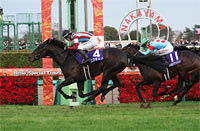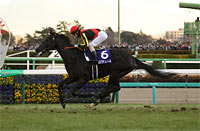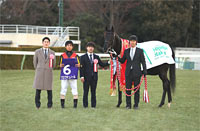Hopeful Stakes (G1) - Data Analysis
2-year-old mid-distance champion decider that sets the stage for next year’s classics
The Hopeful Stakes (upgraded to G1 status in 2017) is positioned as the 2-year-old middle-distance champion decider, setting it apart from the Hanshin Juvenile Fillies and the Asahi Hai Futurity Stakes, two races that are run over a distance of 1,600m. The race was contested on the turf 2,000m course at Hanshin Racecourse under the name Radio Nikkei Hai Nisai Stakes until 2013. Let’s now analyze some trends in this race over the last 10 years, including the period during which it was held as the Radio Nikkei Hai Nisai Stakes.
Runners that contested a turf 2,000m race in their last outing have enjoyed success in recent years
Looking at performances by runners over the last 10 years in terms of the distance of their previous race, we observe that runners that contested “a turf 2,000m race” similar to the Hopeful Stakes in their last outing produced eight winners and achieved the highest win ratio. That said, runners that contested “a turf 1,600m race” in their last outing delivered the highest Top 2 and Top 3 ratios, and runners coming from a “turf 1,800m race” also achieved a higher Top 3 ratio than the “turf 2,000m race” group. However, if we confine our analysis to the races held at Nakayama Racecourse from 2014, we find that runners that contested a “turf 2,000m” in their last outing produced all four winners, one of the four runners-up, and two of the four third-place finishers. In other words, runners that contested a “turf 2,000m” in their last outing have performed well in recent years. [Table 1]
[Table 1] Performance by distance of previous race (last 10 years)
Distance of
previous race |
Performance
[1st-2nd-3rd-4th or lower] |
Win ratio |
Top 2 ratio |
Top 3 ratio |
| Turf 1,400m |
0-0-0-2 |
0% |
0% |
0% |
| Turf 1,600m |
0-4-1-11 |
0% |
25.0% |
31.3% |
| Turf 1,800m |
2-5-6-40 |
3.8% |
13.2% |
24.5% |
| Turf 2,000m |
8-1-3-49 |
13.1% |
14.8% |
19.7% |
| Dirt race |
0-0-0-8 |
0% |
0% |
0% |
Note: Based on data for Radio Nikkei Hai Nisai Stakes in 2008-2013, and Hopeful Stakes from 2014.
Runners with 2 wins on turf are strong performers
Looking at performances by runners over the last 10 years in terms of the number of wins in JRA turf races, we note that runners with “2 wins” achieved substantially better success ratios than runners with “1 win” or “0 wins.” If we confine our analysis to the races held at Nakayama Racecourse from 2014, we find that runners with “2 wins” delivered two winners and three runners-up, for a total of five of the eight Top 2 finishers. Incidentally, runners with “1 win” in a JRA turf race have delivered two winners since 2014, and both had a track record of “1 start, 1 win.” In addition, none of the runners over the last 10 years had achieved three or more wins in JRA turf races. [Table 2]
[Table 2] Performance by number of wins in JRA turf races (last 10 years)
| Number of wins |
Performance
[1st-2nd-3rd-4th or lower] |
Win ratio |
Top 2 ratio |
Top 3 ratio |
| 2 wins |
5-6-3-18 |
15.6% |
34.4% |
43.8% |
| 1 win |
5-4-7-84 |
5.0% |
9.0% |
16.0% |
| 0 wins |
0-0-0-8 |
0% |
0% |
0% |
Note: Based on data for Radio Nikkei Hai Nisai Stakes in 2008-2013, and Hopeful Stakes from 2014.
Watch time difference with runner-up in first win on turf
Looking at performances by runners over the last 10 years in terms of the time difference with the runner-up in their first turf race victory, we observe that runners with a time difference of “0.3-0.6s” achieved the highest success ratios (after excluding the only three runners with a time difference of “0.7s or above”). However, if we confine our analysis to the races held at Nakayama Racecourse from 2014, we find that the runners with a time difference of “0.1-0.2s” produced three winners and three runners-up, and the runners with a time difference of “0.3-0.6” one winner and one runner-up. In recent years, runners with a “0.1-0.2s” time difference with the runner-up in their first JRA turf race victory have often performed well. [Table 3]
[Table 3] Performance by time difference with runner-up in first JRA turf race victory (last 10 years)
Time difference with
runner-up |
Performance
[1st-2nd-3rd-4th or lower] |
Win ratio |
Top 2 ratio |
Top 3 ratio |
| No time difference |
0-2-1-21 |
0% |
8.3% |
12.5% |
| 0.1-0.2s |
5-3-4-45 |
8.8% |
14.0% |
21.1% |
| 0.3-0.6s |
5-4-4-35 |
10.4% |
18.8% |
27.1% |
| 0.7s or above |
0-1-1-1 |
0% |
33.3% |
66.7% |
| No victory in JRA turf race |
0-0-0-8 |
0% |
0% |
0% |
Note: Based on data for Radio Nikkei Hai Nisai Stakes in 2008-2013, and Hopeful Stakes from 2014.
Check time difference with winner in previous races that ended in defeat
Looking at performances by runners over the last 10 years in terms of the time difference when defeated within their two previous races, what stands out immediately is that runners that “had not suffered a defeat in a JRA turf race within their last two outings” achieved the highest success ratios. Among runners that had experienced a defeat in a JRA turf race within their last two outings, only runners with “no time difference,” or a time difference of “0.1-0.2s” or “0.3-0.4s” produced winners in the Hopeful Stakes. Conversely, runners with a time difference of “0.7s or above” or runners that had “not contested a JRA turf race within their last two outings” produced zero Top 3 finishers. However, if we confine our analysis to the races held at Nakayama Racecourse from 2014, we find that eight of the 12 Top 3 finishers had not experienced a defeat in a JRA turf race within their last two outings, while the remaining four Top 3 finishers had a time difference of “0.4s or below” with the winner in their respective defeats. [Table 4]
[Table 4] Performance by highest time difference with winner in JRA turf race that ended in defeat within last two outings (last 10 years)
Highest time difference
with winner |
Performance
[1st-2nd-3rd-4th or lower] |
Win ratio |
Top 2 ratio |
Top 3 ratio |
| No time difference |
1-1-0-8 |
10.0% |
20.0% |
20.0% |
| 0.1-0.2s |
1-1-1-21 |
4.2% |
8.3% |
12.5% |
| 0.3-0.4s |
1-2-2-14 |
5.3% |
15.8% |
26.3% |
| 0.5-0.6s |
0-2-1-11 |
0% |
14.3% |
21.4% |
| 0.7s or above |
0-0-0-26 |
0% |
0% |
0% |
No defeat in JRA turf race
within last two outings |
7-4-6-23 |
17.5% |
27.5% |
42.5% |
Not contested a JRA turf race
within last two outings |
0-0-0-7 |
0% |
0% |
0% |
Note: Based on data for Radio Nikkei Hai Nisai Stakes in 2008-2013, and Hopeful Stakes from 2014.
Seek out the winner!
Straight wins by runners that contested last two races as 2nd favorite or higher
Looking at performances by the four winners since the race was held at Nakayama Racecourse from 2014 in terms of favoritism in their last two outings, we find that two of the winners were backed as “1st favorite” in their last two outings, while the remaining two winners had only one career start and were backed in their debut race as 1st or 2nd favorite. We should therefore focus on runners that were highly favored in their last two outings. [Table 5]
[Table 5] Favoritism of winners in last two outings (last 4 years)
| Year |
Winner |
Favoritism two races back |
Favoritism in last outing |
| 2014 |
Shining Lei |
- |
2nd |
| 2015 |
Hartley |
- |
1st |
| 2016 |
Rey de Oro |
1st favorite |
1st |
| 2017 |
Time Flyer |
1st favorite |
1st |
Note: Shining Lei and Hartley only had one career start.
(Michio Kawano)
|

- Preview
- Barrier draw
- Past performances of runners

- News
- Race result
- Video
- 2025 English

- 2024 English

- 2023 English

- 2022 English

- 2021 English

- 2020 English

- 2019 English

- 2018 English

- 2017 English

- 2016 English

- 2015 English

- 2014 English

- 2013

- 2012

- Photo Gallery
2025 Winner: Lovcen


2024 Winner: Croix du Nord


|



















